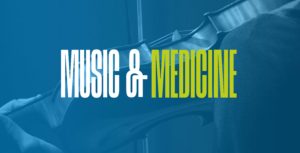
Music & Medicine Concert and Talk
Friday, November 12 at 7:30 – 9:00 pm
The evening will feature a conversation with Dr. Lisa Wong of Harvard Medical School and Geoff Edgers of The Washington Post. They will discuss numerous topics, including what happens in your brain when you play music, which composers were also connected to the medical field, and how music has become more deeply used as a therapy to treat patients.

The CCM faculty trio will present Sergei Rachmaninoff’s Trio elegiaque No. 1 and works by Jean-Marie Leclair, Astor Piazzolla, and contemporary composer Judith Weir.
This concert is made possible by the generous support of Emerson Hospital.
Purchase tickets in advance or payable at the door.
Concert and Masterclass with Joe K. Walsh and Matt Munisteri
Saturday, November 20, Masterclass at 5:00 pm and Concert at 7 pm
Guitarist Matt Munisteri and mandolinist Joe K. Walsh, both instrumental virtuosos, singers, and world-traveling improvisers, explore and expand the shared language running through bluegrass, jazz, and swing music. Driven by their deep faith in the improvised moment and the shared musical conversation full of surprises, they draw from the deep well of American music in crafting their shared sound. Joe and Matt will take you through the process of using melody as the springboard for improvisation during the masterclass.
Purchase tickets in advance or payable at the door.
Are you a CCM friend yet?
Join us on Instagram and Facebook to be the first to learn CCM news and more! See what music videos we like, photos we post, practice tips and articles we suggest, and new music in the music world. Be sure to bookmark the CCM Blog so you never miss a new post.

How does Egle Jarkova feel about “Vivace Vilnius,” the International Summer Music Festival she founded in her native Lithuania a decade ago? That depends on when you ask her. “Every year when I get back to Boston, I say, ‘I will never do that again!’” Egle says with a laugh. “But then two months later, I’m raising money again.”
That speaks to both the level of commitment the project requires and Egle’s passion for it. Putting on any kind of festival is daunting. What makes staging “Vivace Vilnius” doubly so is Egle’s insistence that every aspect of the festival be available for free — not only the master classes for students, which are an essential part of the festival, but also the actual performances.
Why is that so important? “Music is a really big part of Lithuanian culture,” Egle says. Indeed, world-renowned violinist Jascha Heifetz was born in what is now Vilnius. “And we have a lot of concert halls, museums, and 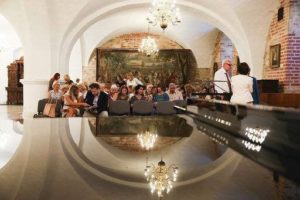 performance spaces,” Egle adds.
performance spaces,” Egle adds.
Unfortunately, those concert halls had become inaccessible to a large segment of the populace. “Many years ago, concerts in Lithuania were free,” Egle says. “But now if you want to see a classical concert you have to buy a ticket. And a lot of people in Lithuania cannot afford that. So I wanted to use the best halls and museums, and let everyone come and listen to this music for free.”
Paying It Forward
For Egle, the festival amounts to a passing of the torch — a chance for today’s young Lithuanians to have the same opportunities that she did. “I was five years old when I started violin,” Egle says. “My mother had five kids, and everybody had to do something — music, art or dance. So she brought me to a music school.”
By age 11, Egle had progressed on the violin to the point where she was invited to a competition at the National M. K. Ciurlionis Art School in Vilnius, Lithuania’s capital. “All the gifted young musicians were encouraged to go there,” Egle says. Essentially, this was the moment of decision for the country’s budding young musicians. Did they want to pursue music more seriously or not?
“And I did,” Egle says.
Did she ever.
Applying What She’s Learned
At 17, Egle left Lithuania to study in Italy, starting down a path that has taken from United World College of the 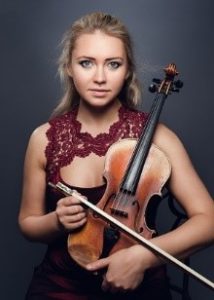 Adriatic to the Boston Conservatory and Boston University, where she received her Master’s in the violin in 2016. She has performed in more than 10 countries, at a range of venues that includes Carnegie Hall.
Adriatic to the Boston Conservatory and Boston University, where she received her Master’s in the violin in 2016. She has performed in more than 10 countries, at a range of venues that includes Carnegie Hall.
But she is never more at home than when she is instructing her students at CCM. Most of her charges are unaware of her world-class credentials — and Egle prefers it that way. “That makes it easier to establish a connection and make kids comfortable, because you’re just connecting as two people,” she says. “Your skills as a teacher, or even as a violinist, really don’t matter at that point. You have to make that human connection first.”
Challenging Changes
What can be difficult at times, Egle acknowledges, is reaching students in a world increasingly dominated by screens and shrinking attention spans. “Kids are preoccupied with so many other activities,” Egle says. “So I try to give them a little of everything at every lesson — not just playing the instrument. For example, I might ask them to do a little research about a composer we’re playing.”
That gives her an opportunity to use kids’ digital fixation to her advantage. “I always tell my students, ‘When I grew up, I didn’t have a computer or internet access. When the teacher asked me to research something, I had to go find it in a book.’” She laughs. “Then I tell them, ‘I promise it will only take you one minute to look up that name on the internet.’ Students usually love that challenge.”
One thing hasn’t changed about music education, Egle says: “A lot of it comes down to how much the student is willing to do at home.”
A Lifetime of Learning
Few students have done more at home than Egle; founding a music festival in her native country is proof enough of that. And although she is an accomplished teacher now, Egle also remains a student, open to whatever lessons come her way. She has learned, for example, that she has to limit her own performances at the festival if she wants to stay on top of all the details. “I don’t have enough of a budget to hire the help, so it’s a case of ‘If you want something done right, do it yourself,’” she says. “I raise the money, I invite the artists, I book the hotels, I book the flights, I pick people up at the airport, I bring people food — I even teach and perform, and many times mentor the younger students.” Performing, the thing she loves most, had to be limited in her own festival.
Egle is proud that the musicians she invites are at the top level, both the pedagogues and performers. “Concerts are 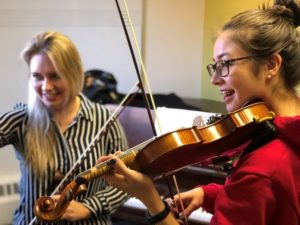 full — you cannot find a seat,” Egle says. Over the last 10 years, the festival has organized 73 free-of-charge concerts, with over 200 participating students.
full — you cannot find a seat,” Egle says. Over the last 10 years, the festival has organized 73 free-of-charge concerts, with over 200 participating students.
Egle also thinks that having a child of her own (her daughter Evelina is 3½) has made her a better teacher. “It’s changed my approach with my younger students,” she says. “It hasn’t changed my expectations for them, but I think I understand more now about certain types of behavior in younger students or certain moods, or even why parents might ask certain things of me as a teacher.
“That’s especially true when it comes to things outside of music,” Egle adds with a laugh, “like maybe when a child comes in after eating too much candy. Then I just say to myself, ‘OK, you just try to survive this lesson.’”
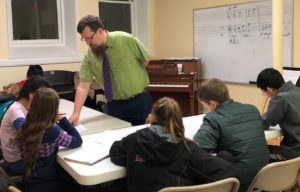
The “Self Indulgent Heavy Metal Guitar Homepage” is an unlikely place to look for insight into music theory. But there it is, in a post by one Tommaso Zillio. “Writing music without theory,” Zillio declares, “is like trying to build a house without proper tools.”
Exactly. And “tools, not rules” is an apt description of CCM’s approach to music theory — which, frankly, can be a challenging subject to get kids excited about. The problem, in part, is the name. “Music theory” sounds so … theoretical. Who wants to hear about music theory when they can hear actual music instead?
Well, here’s the thing: Once you understand music theory, you’re much better equipped to appreciate the kind of music you like to listen to — and even to start creating it. Again, Zillio nails it. Without the right tools, he writes, “You do what you can to find other methods to make things work, like picking up a nearby rock to hammer a nail in. It is possible, but not the most efficient.”
If you’re at CCM, you’re ready to put away the rocks and start using a proper hammer.
Improve Your Music Literacy
Maybe we can best answer the question of why we need music theory with another question: Why do we need 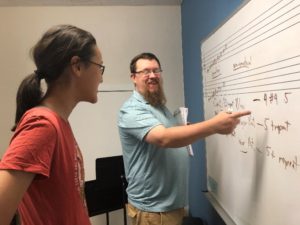 language?
language?
The answer, in both cases, is to enable better communication. “Music theory gives a vocabulary to communicate across instruments,” says CCM music theory instructor Peter Evans. “Because you do have to know some basics, like different types of scales and different sizes of intervals. But I try to come at it by playing actual music.”
Peter used to use a piano to demonstrate the building blocks of music theory. But he realized it wasn’t easy for students who played something other than a keyboard to relate what they were hearing (and seeing) on the piano to their own instruments.
He hit upon a creative alternative. “It’s an old, cheap ukulele with only one string left,” he says. “I was going to get rid of it, but I found it can be really helpful because everything is very straightforward, like the frets in relation to the string. So when you move your hand a little bit, the analog is exact from one half-step to another.”
Compare that to a piano, where the transition from white keys to black keys makes the principles more abstract and harder to grasp. With the single-string ukulele, by contrast, “No matter which instrument a student plays, they can see the correlation.”
Fine-Tune Your Appreciation
It is that revelation, that “Aha!” moment when the what, the why, and the how all come together, that makes music theory relevant. Providing those insights is especially important in today’s world, in which music has become ubiquitous. From ringtones to stadium rock to cartoon sound effects to commercial jingles, music is a part of every child’s soundscape from an early age.
It can be a challenge to get young kids to stop thinking of music as background noise and inspire them to appreciate it as an art form. Peter does that at every level, from beginners to the collegiate courses he teaches in addition to his work at CCM. His goal is to get students to perceive both the forest and the trees.
“You have to start with some basics,” he says. “Then you demonstrate those basics by playing something. And all of a sudden it’s, ‘Oh, so that’s how it works.’ And that starts to give each student that glimpse of what makes music an art and not just a thing that you’re practicing.”
Music Theory Rules!
OK, we’ll admit it: We’ve been doing the limbo, bending over backward as we’ve tried to dance around the word “rules” when it comes to explaining music theory. But in the end — yes, music theory is at least a little bit about rules.
But the point of the rules is not to inhibit budding musicians. In fact, it is to encourage them. A solid foundation in music theory gives musicians of any age new confidence. Once they understand the theory, they can listen to a new piece of music and determine what key it is in, as well as the time signature. That sets the stage for them to begin improvising on the melody. 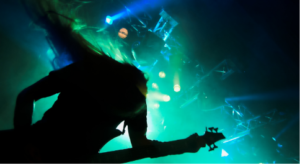
From there, their confidence continues to grow. That’s one of the things that parents value about their children’s music education at CCM. With music theory, we not only show students where the boundaries are — we also encourage students to push them.
That’s when the fun truly begins. Push those musical boundaries, and who knows where you’ll end up. You might even find yourself on the Self Indulgent Heavy Metal Guitar Homepage.
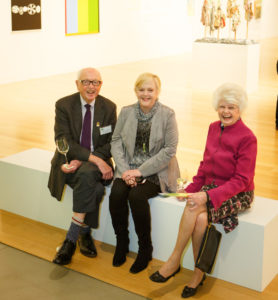
When Ray Miller walked into CCM back in 2012, he came to fulfill a challenge made by his grandson to learn to play the piano. We recently lost our piano student, former board member, friend, and mentor at 87. I was honored to have Ray agree to serve on our board. He brought a wealth of leadership skills, financial acumen and was a genuinely kind person that cared about CCM and our success. Even after he finished his tenure on the board, Ray would often visit me in my office and ask, “how’s our balance sheet?” I would also hear with great enthusiasm the comings and going of his large and extended family, knowing the details of each grandchild and which ones he believed were dating “long-term prospects.” I’d like to share the article about Ray that was originally published in our 2013 Upbeat newsletter, titled The Value & Beauty of Music. Ray is fittingly pictured with his wife of over 65 years Margot Miller. Obituary
Kate Yoder, Executive Director & Founder

What else are doctors, nurses, and therapists relying on to help patients heal mentally and physically? A dose of music therapy.
Music therapy is based on evidence from numerous research studies and is now used at many leading hospitals and recommended by highly-regarded medical professionals. From one to 100, patients of all ages benefit from music used in partnership with good medicine.
Take Willow, a one-year-old cancer patient at Phoenix Children’s Hospital. Music therapy for her goes well beyond distracting her from discomfort. “The music is tapping into the part of her brain – the “control tower” that tells the rest of her body what to do. In this case, slow down her heart rate, reduce toxins that cause stress, and begin the process of healing. And also, promote her continued development, despite spending so many hours confined to the hospital room.” (Diane Meehl for Phoenix Children’s Hospital)
Now more than ever, live music can be heard throughout different departments in a hospital, including surprising places like a neonatal intensive care unit to soothe those vulnerable newborns. It’s well-known that music and music therapy calms and relaxes patients. So much so that the Mass General Environmental Music Program recruits highly-talented musicians to perform live music in the hospital’s public spaces to help their patients, families, as well as their staff. MGH tries to create restful and pleasant spaces by distracting people with music to lighten their moods. The standard sterile hospital spaces are transformed with music helping to relax patients and other visitors. Musicians can be heard playing in outpatient cancer care floors, inpatient pediatric areas, and the main lobby.
According to the American Music Therapy Association, creating, singing, moving to, and listening to music helps strengthen and widen a patient’s capabilities. We’ve always endorsed the benefits of music for everyone—cognitive, emotional, social, and physical benefits, and leading experts in the field agree with us. The Cleveland Clinic provides a list of music therapy benefits that include lowering blood pressure, improving memory, reducing muscle tension, managing pain, and increasing happiness
helps strengthen and widen a patient’s capabilities. We’ve always endorsed the benefits of music for everyone—cognitive, emotional, social, and physical benefits, and leading experts in the field agree with us. The Cleveland Clinic provides a list of music therapy benefits that include lowering blood pressure, improving memory, reducing muscle tension, managing pain, and increasing happiness
Music therapy is often enlisted to help with specific health issues such as Alzheimer’s or Parkinson’s Disease, stroke, brain injury, and a host of other ailments. The evidence shows that music therapy works. The Executive Editor of Harvard Women’s Health Watch, Beverly Merz, goes even further and says that music therapy is not just a nice perk. It can improve medical outcomes and quality of life by reducing anxiety during medical procedures, helping restore lost speech, reducing side effects of cancer therapies, and giving some relief from pain.
As CCM voice instructor and leader of the Singing with Parkinson’s Chorus, Jay Lane says, “Music has so many therapeutic benefits! Singing with others gives you endorphins; playing an instrument builds connections between the left and right brain; dancing improves your balance—the list seems to grow all the time as we discover more and more. The important thing is not to get hung up on perfection—just get out there and make music!”
therapeutic benefits! Singing with others gives you endorphins; playing an instrument builds connections between the left and right brain; dancing improves your balance—the list seems to grow all the time as we discover more and more. The important thing is not to get hung up on perfection—just get out there and make music!”
Since ancient times music has been used as a soothing and therapeutic tool. In 1945, music therapy was used to help returning soldiers from the war overcome trauma. Music continues to be used today to help soldiers reduce their anxieties and to cope with depression.
Even though we know music has special powers, it’s certainly not the only medication or treatment patients need to heal. But it sure is the ideal collaborative partner for medicinal treatments and surgical procedures.
Discover more about the fascinating intersection between music and medicine by attending  CCM’s Music & Medicine Concert and Talk on Friday, November 12 at 7:30 pm.
CCM’s Music & Medicine Concert and Talk on Friday, November 12 at 7:30 pm.
The evening will feature a conversation with Dr. Lisa Wong of Harvard Medical School and Geoff Edgers of The Washington Post. They will discuss numerous topics, including what happens in your brain when you play music, which great composers were also connected to the medical field, and how music has become more deeply used as a therapy to treat patients.
Plus, you’ll experience a chamber music performance by CCM faculty members Yelena Beriyeva on piano, Egle Jarkova on violin, and Stephen Marotto on cello.
Purchase your tickets today, and we’ll see you there!